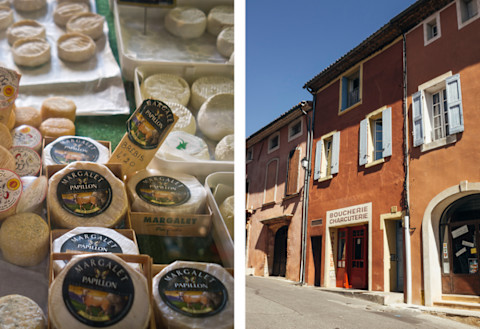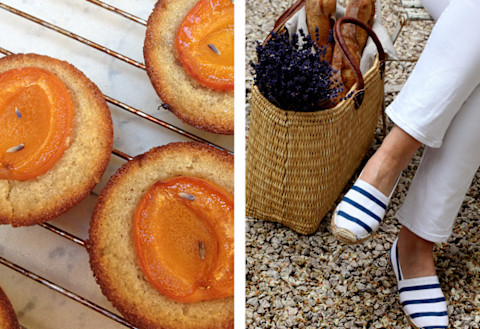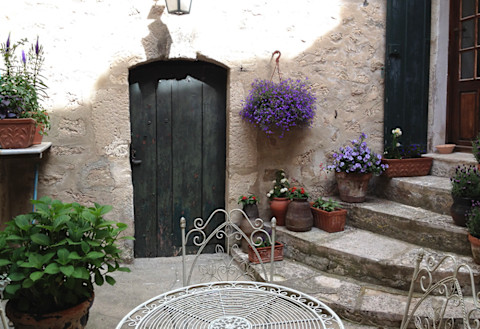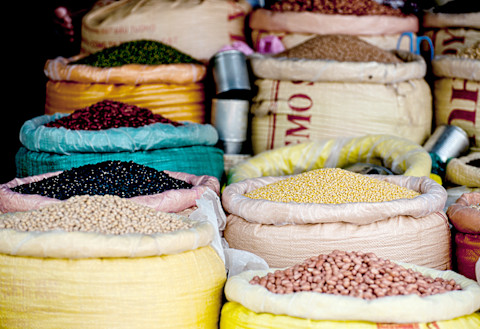Elizabeth Bard is American writer who, 15 years ago, went to lunch with a handsome Frenchman "and basically never went home." She lived with her husband in Paris for eight years before moving to Céreste, a tiny village in Provence, where they started Scaramouche, an artisan ice cream company. Her new book, Dinner Chez Moi: 50 French Secrets to Joyful Eating and Entertaining, is filled with tips, tricks, and recipes that have added a lot of joie de vivre to her daily cooking and entertaining. Here, she shares 14 French secrets to eating well.

1. The French don't snack.
By and large, adults don't eat between meals. Food has a defined time and place (three meals a day, plus coffee). The kids get an afternoon gouter each day after school, and the adults might join them on the weekends. The French don't eat while walking, driving, or working. I once had a homeless man tell me to watch my weight when he saw me speed walking toward the metro while chomping on a pain au chocolat.
2. French portions are way smaller than American portions.
Like a lot of newcomers to France, I used to wonder how the French can eat bread, cheese, dessert, and drink wine and still look the way they do. Some of it is basic math: A French portion is half what an American portion might be and takes three times as long to eat. It took me several years to learn to pace myself at a French dinner party. The French still serve meals in courses. The main course may not look like enough; you've had your aperitif and appetizer beforehand, and the cheese and dessert are still to come.
3. There's no takeout.
In my village of 1,300 people, at least. Because of this, I cook almost every night. A typical weeknight dinner in our house might be thick vegetable soup with bread and cheese or whole wheat pasta with a quick homemade tomato sauce. I make fish on Thursdays and Fridays, when I can buy it fresh from the market. I often buy whole fish, which is simple to broil—the skin protects the fillets. We are eating less and less meat—though in the winter months I make a weekly pot of braised lamb or pork that lasts two or three meals. Dessert is whatever fruit is in season, or a small pot of plain yogurt with a dollop of jam. You'd think since we own an ice cream shop, we'd have ice cream every night, but somehow we don't. I'm putting in a complaint to the management.

4. Herbal tea can curb hunger—and cure a cold.
My French mother-in-law introduced me to the idea of drinking herbal tea throughout the day. It cuts appetite and keeps me hydrated. Plain dried herbs like mint, lemon verbena, chamomile, fennel seed, and orange flower and licorice root are widely available. I use thyme tisane I buy at the local pharmacy (or fresh thyme) when I have a cold or a respiratory infection. After lunch or dinner, I'll often have a square of dark chocolate with my tea.
5. Sometimes traditional is better.
When it comes to food, the French are all about tradition and taste, not innovation or silver bullet solutions.
6. Don't be afraid of eating animals—and don't waste them either.
Every time I post a picture of a chicken, rabbit, or fish with the head on, at least one of my American readers gets really yucked out. I get it—I grew up buying meat under cellophane too. The French love a cute dog in a handbag as much as (maybe more than) the next person, but they are also pragmatic and utterly unsentimental about eating animals. They are also closer to the memory of the war years and rationing—so nothing (liver, tripe, oxtail, kidneys) goes to waste.
7. Soup is a magical cure-all.
Soup is thought to have magical properties in France. Sick? Have some soup. Want your kids to eat green vegetables? Try soup. Lunch is still the main meal of the day here, so a vegetable soup with some ham or cheese is a perfectly acceptable dinner. The French like their soup the Vitamix way—as creamy veloutés rather than the Chunky Soup of my childhood. I use my immersion blender more than any other piece of equipment in my kitchen. I usually make soup from a single vegetable—pumpkin, broccoli, or zucchini. I add the steamed vegetables to a base of onion sautéed in a generous amount of olive oil. The olive oil adds richness without using milk or cream—and doesn't hide the taste of the veggies.

8. Local can be more important than organic.
The French are a lot closer to their agricultural past than we are in the States, so most French people still know what a real strawberry tastes like. The locavore habit comes very naturally to us in Provence because we are living in the fruit basket of France. Neighbors leave bags of tomatoes and have us come to pick the cherries off their trees. When you know your local producers, as we do because we source the fruit for Scaramouche, our ice-cream company, we've found organic isn't always a guarantee of quality. The label is expensive for farmers to get and maintain, so there are many great products farmed under the label "agriculture raisonnée," which literally translates to "reasonable" (and environmentally friendly) farming. GMO fruits and vegetables are illegal in France.
9. Ancient grains aren't a trend—they're a culinary staple.
Petit épeautre (einkorn wheat) has been grown in Provence for thousands of years. Is the most ancient form of wheat (never hybridized). It is nutrient rich and contains a form of gluten that is more easily digestible for some with gluten intolerance. I use it in soups and stews—it gives you a nutty flavor and a creamy risotto consistency without the constant supervision. Einkorn flour is great for crepes or even cookies.
10. Dieting has no place here.
Preparing and sharing food is one of—perhaps the essential—pleasure of French culture. Healthy food in France comes from moderation. There are no forbidden foods, only excess is looked down upon. The French have never been afraid of fat, so a small portion is often very satisfying. For me, it's been a change of paradigm: What Americans call "dieting": smaller portions, less sugar (the French like their desserts rich, rather than sweet), a preference for seasonal fruits and vegetables, limited meat (it's really expensive)—the French simply call this "eating," and they do it with such gusto and flair.
11. Who you eat with is as important as what you eat.
Mealtimes are still family time in France. Families eat together—and the kids eat later (around 7 or 7:30), with their parents. Many people still drink a glass of wine with lunch or dinner. We drink water with meals, wine or Champagne with guests. The French love to entertain. In Provence, it tends to be long summer evenings in the garden or out on the terrace of a restaurant.

12. Good eating habits start young.
I'm pretty sure school lunch is how they create little French people—start with the lentil salad and move up from there. My 7-year-old son eats at the canteen every day. It's a three- or four-course lunch served family style at a round table: appetizer, main course, cheese, and/or dessert. There is only one choice; kids are not allowed to bring lunch from home. They can go home for the midday meal, but if they stay, they eat what's on offer. My son learned to eat things at la canteen that he wouldn't touch at home, like creamed spinach with hard-boiled eggs. There's something about being hungry at noon—and being with his friends—that makes all the difference.
13. Small markets trump grocery stores.
Each little village has a weekly outdoor market, sometimes it's only a few vendors. I get my fish at the Céreste market on Thursdays (we are lucky to have a fishmonger who drives the 150 kilometers from the Mediterranean Coast each week). I get my meat at the village butcher (there's always a line—so it's also the best place to catch up on village news—or to start a rumor…). I only go to the big supermarket once every three or four months, to get staples like toilet paper, cleaning products, chocolate, and canned sardines, and dry goods like pasta, quinoa, and oatmeal. I fill in my weekly staples like yogurt, eggs, and chickpeas from the small superette in the village.
14. Never say never.
Instead of no carbs, they will eat a small slice of cake. My mother-in-law doesn't refuse the side of fries with her steak tartare, but she always leaves some on the plate. Above all, the French are not afraid of their food; they love it, and they trust themselves around it. I think of it as the difference between "cheating" and "treating."
